sensor Alfa Romeo 147 2010 Owner handbook (in English)
[x] Cancel search | Manufacturer: ALFA ROMEO, Model Year: 2010, Model line: 147, Model: Alfa Romeo 147 2010Pages: 291, PDF Size: 5.52 MB
Page 94 of 291
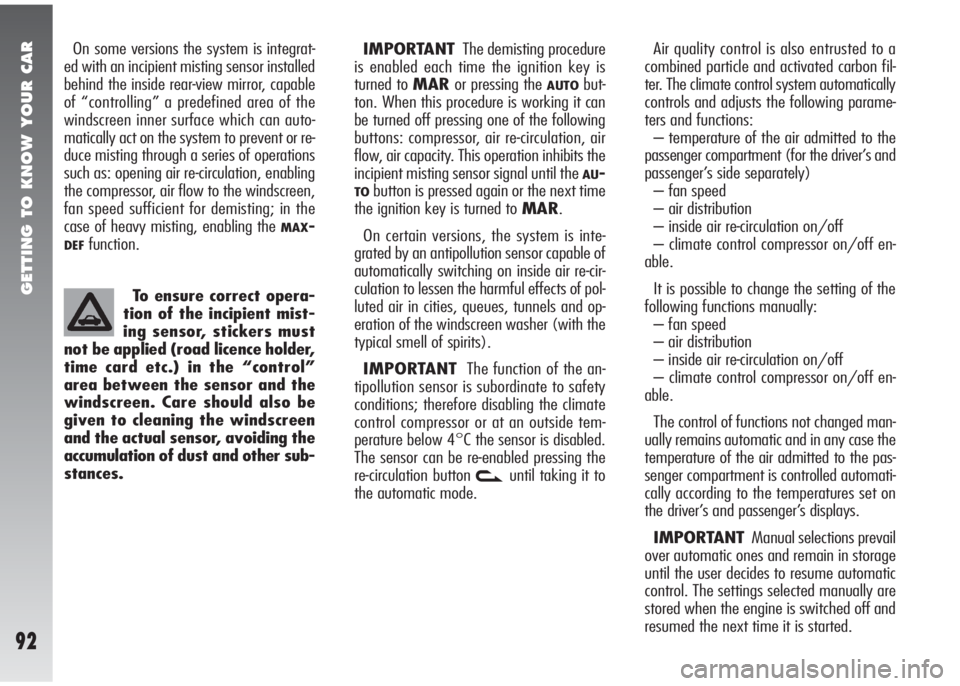
GETTING TO KNOW YOUR CAR
92
Air quality control is also entrusted to a
combined particle and activated carbon fil-
ter. The climate control system automatically
controls and adjusts the following parame-
ters and functions:
– temperature of the air admitted to the
passenger compartment (for the driver’s and
passenger’s side separately)
– fan speed
– air distribution
– inside air re-circulation on/off
– climate control compressor on/off en-
able.
It is possible to change the setting of the
following functions manually:
– fan speed
– air distribution
– inside air re-circulation on/off
– climate control compressor on/off en-
able.
The control of functions not changed man-
ually remains automatic and in any case the
temperature of the air admitted to the pas-
senger compartment is controlled automati-
cally according to the temperatures set on
the driver’s and passenger’s displays.
IMPORTANTManual selections prevail
over automatic ones and remain in storage
until the user decides to resume automatic
control. The settings selected manually are
stored when the engine is switched off and
resumed the next time it is started. To ensure correct opera-
tion of the incipient mist-
ing sensor, stickers must
not be applied (road licence holder,
time card etc.) in the “control”
area between the sensor and the
windscreen. Care should also be
given to cleaning the windscreen
and the actual sensor, avoiding the
accumulation of dust and other sub-
stances.IMPORTANTThe demisting procedure
is enabled each time the ignition key is
turned to MARor pressing the
AUTObut-
ton. When this procedure is working it can
be turned off pressing one of the following
buttons: compressor, air re-circulation, air
flow, air capacity. This operation inhibits the
incipient misting sensor signal until the
AU-
TObutton is pressed again or the next time
the ignition key is turned to MAR.
On certain versions, the system is inte-
grated by an antipollution sensor capable of
automatically switching on inside air re-cir-
culation to lessen the harmful effects of pol-
luted air in cities, queues, tunnels and op-
eration of the windscreen washer (with the
typical smell of spirits).
IMPORTANTThe function of the an-
tipollution sensor is subordinate to safety
conditions; therefore disabling the climate
control compressor or at an outside tem-
perature below 4°C the sensor is disabled.
The sensor can be re-enabled pressing the
re-circulation button
vuntil taking it to
the automatic mode. On some versions the system is integrat-
ed with an incipient misting sensor installed
behind the inside rear-view mirror, capable
of “controlling” a predefined area of the
windscreen inner surface which can auto-
matically act on the system to prevent or re-
duce misting through a series of operations
such as: opening air re-circulation, enabling
the compressor, air flow to the windscreen,
fan speed sufficient for demisting; in the
case of heavy misting, enabling the
MAX-
DEFfunction.
Page 95 of 291
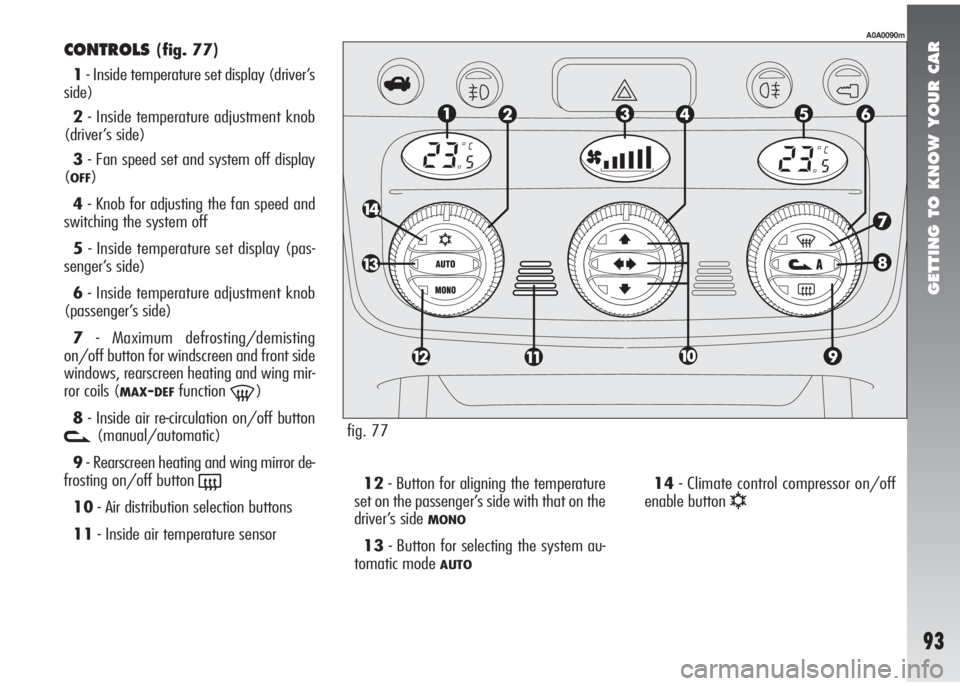
GETTING TO KNOW YOUR CAR
93
CONTROLS(fig. 77)
1- Inside temperature set display (driver’s
side)
2- Inside temperature adjustment knob
(driver’s side)
3- Fan speed set and system off display
(
OFF)
4- Knob for adjusting the fan speed and
switching the system off
5- Inside temperature set display (pas-
senger’s side)
6- Inside temperature adjustment knob
(passenger’s side)
7- Maximum defrosting/demisting
on/off button for windscreen and front side
windows, rearscreen heating and wing mir-
ror coils (
MAX-DEFfunction-)
8- Inside air re-circulation on/off button
v(manual/automatic)
9- Rearscreen heating and wing mirror de-
frosting on/off button
(
10- Air distribution selection buttons
11- Inside air temperature sensor12- Button for aligning the temperature
set on the passenger’s side with that on the
driver’s side MONO
13- Button for selecting the system au-
tomatic mode
AUTO
14- Climate control compressor on/off
enable button
√
fig. 77
A0A0090m
Page 104 of 291

GETTING TO KNOW YOUR CAR
102
INSIDE AIR RE-CIRCULATION
ON/OFF BUTTON
v(fig. 87)
Inside air re-circulation is controlled ac-
cording to three operating logics
- automatic control, indicated by the turn-
ing on of the right led on the button;
- forced engagement (inside air re-circula-
tion always on), indicated by the turning on
of the left led on the button (and by the right
led going off at the same time);
- forced switching off (inside air re-circula-
tion always off with air inlet from outside),
indicated by the turning off of both leds.
These operating conditions are obtained
pressing in sequence the inside air re-circu-
lation button (8)
v.
When inside air re-circulation is controlled
automatically by the system, the right ledon the air re-circulation button (8)
v
stays on all the time and the left led shows
the air re-circulation condition:
on= air re-circulation operating;
off= air re-circulation off.
If inside air re-circulation has been turned
on or off manually, the led on button (13)
AUTOturns off.
In automatic operation, inside air re-circu-
lation is turned on automatically when the an-
tipollution sensor detects the presence of pol-
luted air, for example in cities, queues, tun-
nels and operation of the windscreen wash-
er (with the characteristic smell of spirit).
A0A0212m
fig. 87
With the outside temper-
ature below 4°C the cli-
mate control compressor is unable
to work. It is therefore unadvis-
able to use the inside air re-circu-
lation feature
vwith low out-
side temperature as the windows
may quickly mist over.
WARNING
Operation of the climate con-
trol compressor is necessary
for cooling and dehumidifying the air;
it is advisable to keep this function
always on, to prevent window mist-
ing problems.
WARNING
Page 130 of 291
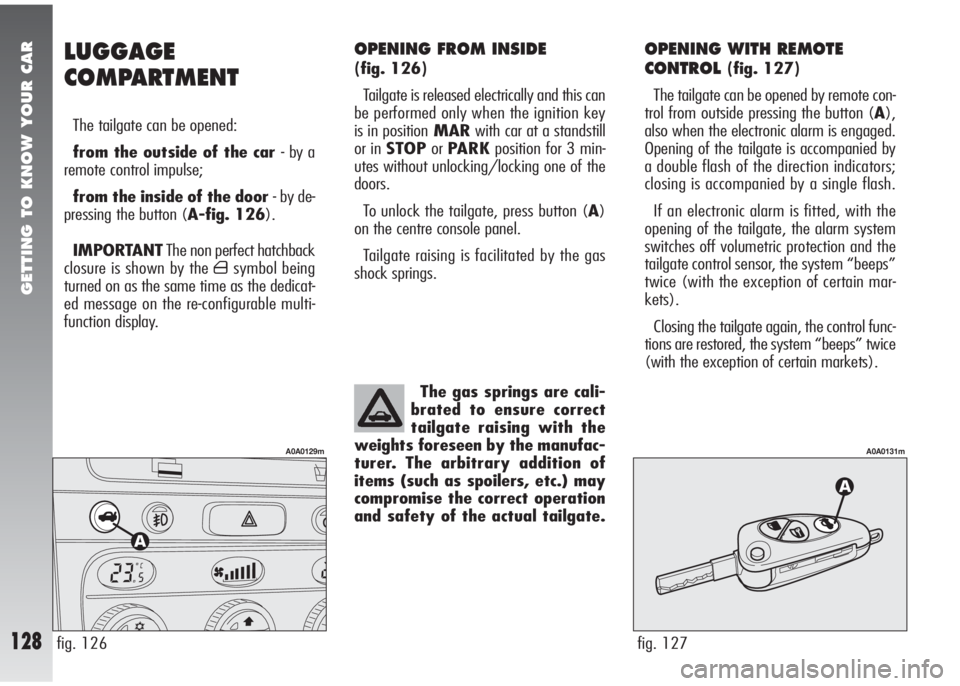
GETTING TO KNOW YOUR CAR
128
OPENING FROM INSIDE
(fig. 126)
Tailgate is released electrically and this can
be performed only when the ignition key
is in positionMARwith car at a standstill
or in STOPorPARKposition for 3 min-
utes without unlocking/locking one of the
doors.
To unlock the tailgate, press button (A)
on the centre console panel.
Tailgate raising is facilitated by the gas
shock springs.
OPENING WITH REMOTE
CONTROL
(fig. 127)
The tailgate can be opened by remote con-
trol from outside pressing the button (A),
also when the electronic alarm is engaged.
Opening of the tailgate is accompanied by
a double flash of the direction indicators;
closing is accompanied by a single flash.
If an electronic alarm is fitted, with the
opening of the tailgate, the alarm system
switches off volumetric protection and the
tailgate control sensor, the system “beeps”
twice (with the exception of certain mar-
kets).
Closing the tailgate again, the control func-
tions are restored, the system “beeps” twice
(with the exception of certain markets).
The gas springs are cali-
brated to ensure correct
tailgate raising with the
weights foreseen by the manufac-
turer. The arbitrary addition of
items (such as spoilers, etc.) may
compromise the correct operation
and safety of the actual tailgate.
fig. 127
A0A0131m
LUGGAGE
COMPARTMENT
The tailgate can be opened:
from the outside of the car - by a
remote control impulse;
from the inside of the door - by de-
pressing the button (A-fig. 126).
IMPORTANTThe non perfect hatchback
closure is shown by the
´symbol being
turned on as the same time as the dedicat-
ed message on the re-configurable multi-
function display.
fig. 126
A0A0129m
Page 137 of 291
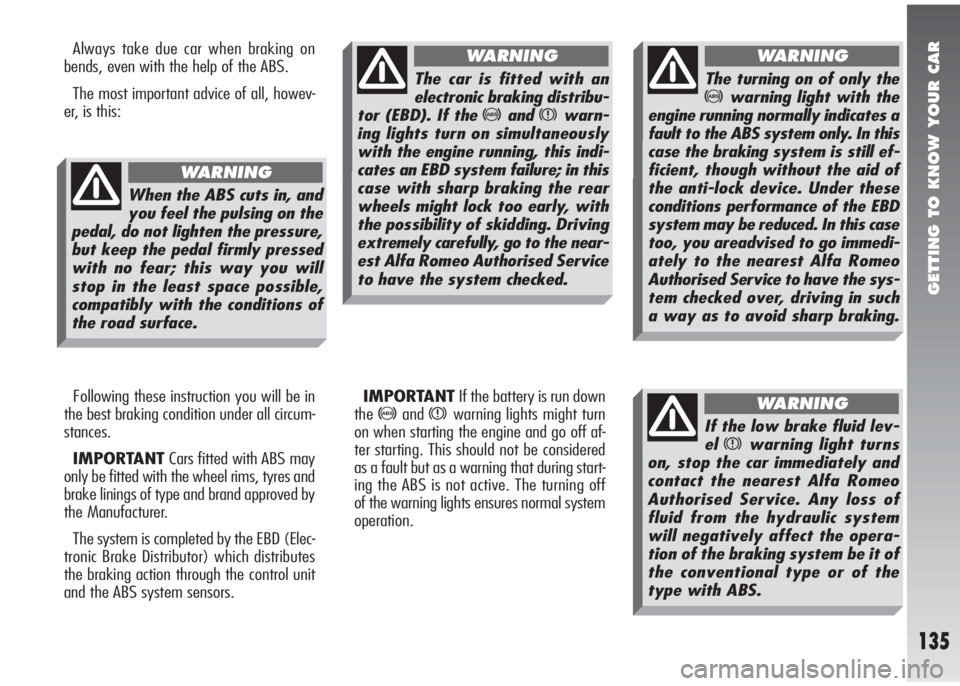
GETTING TO KNOW YOUR CAR
135
Always take due car when braking on
bends, even with the help of the ABS.
The most important advice of all, howev-
er, is this:
Following these instruction you will be in
the best braking condition under all circum-
stances.
IMPORTANTCars fitted with ABS may
only be fitted with the wheel rims, tyres and
brake linings of type and brand approved by
the Manufacturer.
The system is completed by the EBD (Elec-
tronic Brake Distributor) which distributes
the braking action through the control unit
and the ABS system sensors.IMPORTANTIf the battery is run down
the
>andxwarning lights might turn
on when starting the engine and go off af-
ter starting. This should not be considered
as a fault but as a warning that during start-
ing the ABS is not active. The turning off
of the warning lights ensures normal system
operation.
When the ABS cuts in, and
you feel the pulsing on the
pedal, do not lighten the pressure,
but keep the pedal firmly pressed
with no fear; this way you will
stop in the least space possible,
compatibly with the conditions of
the road surface.
WARNING
The car is fitted with an
electronic braking distribu-
tor (EBD). If the
>andxwarn-
ing lights turn on simultaneously
with the engine running, this indi-
cates an EBD system failure; in this
case with sharp braking the rear
wheels might lock too early, with
the possibility of skidding. Driving
extremely carefully, go to the near-
est Alfa Romeo Authorised Service
to have the system checked.
WARNING
The turning on of only the
>warning light with the
engine running normally indicates a
fault to the ABS system only. In this
case the braking system is still ef-
ficient, though without the aid of
the anti-lock device. Under these
conditions performance of the EBD
system may be reduced. In this case
too, you areadvised to go immedi-
ately to the nearest Alfa Romeo
Authorised Service to have the sys-
tem checked over, driving in such
a way as to avoid sharp braking.
WARNING
If the low brake fluid lev-
el
xwarning light turns
on, stop the car immediately and
contact the nearest Alfa Romeo
Authorised Service. Any loss of
fluid from the hydraulic system
will negatively affect the opera-
tion of the braking system be it of
the conventional type or of the
type with ABS.
WARNING
Page 138 of 291
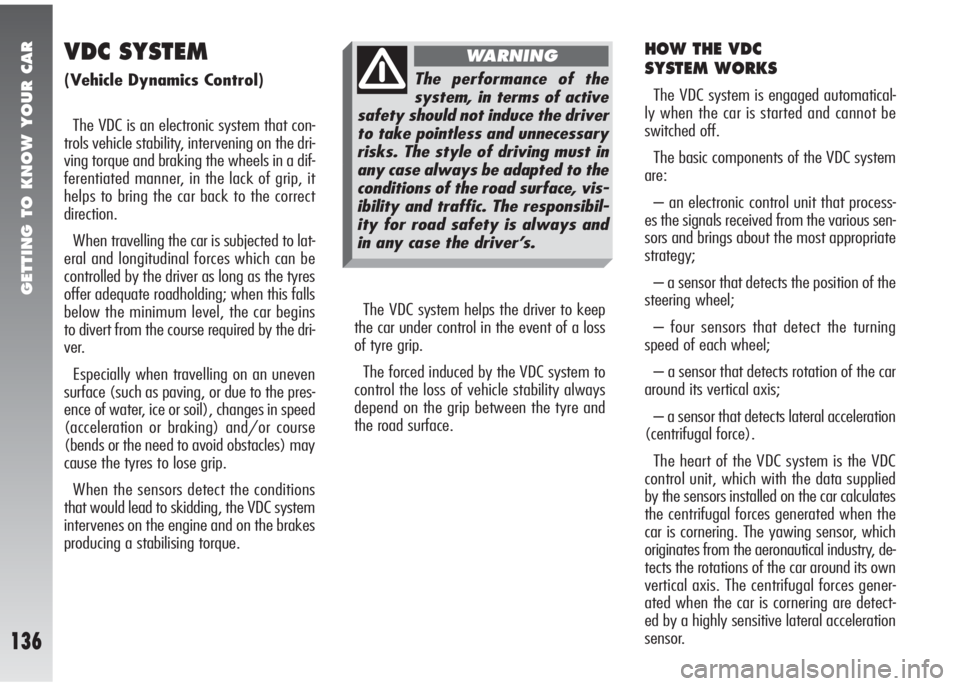
GETTING TO KNOW YOUR CAR
136
VDC SYSTEM
(Vehicle Dynamics Control)
The VDC is an electronic system that con-
trols vehicle stability, intervening on the dri-
ving torque and braking the wheels in a dif-
ferentiated manner, in the lack of grip, it
helps to bring the car back to the correct
direction.
When travelling the car is subjected to lat-
eral and longitudinal forces which can be
controlled by the driver as long as the tyres
offer adequate roadholding; when this falls
below the minimum level, the car begins
to divert from the course required by the dri-
ver.
Especially when travelling on an uneven
surface (such as paving, or due to the pres-
ence of water, ice or soil), changes in speed
(acceleration or braking) and/or course
(bends or the need to avoid obstacles) may
cause the tyres to lose grip.
When the sensors detect the conditions
that would lead to skidding, the VDC system
intervenes on the engine and on the brakes
producing a stabilising torque.
HOW THE VDC
SYSTEM WORKS
The VDC system is engaged automatical-
ly when the car is started and cannot be
switched off.
The basic components of the VDC system
are:
– an electronic control unit that process-
es the signals received from the various sen-
sors and brings about the most appropriate
strategy;
– a sensor that detects the position of the
steering wheel;
– four sensors that detect the turning
speed of each wheel;
– a sensor that detects rotation of the car
around its vertical axis;
– a sensor that detects lateral acceleration
(centrifugal force).
The heart of the VDC system is the VDC
control unit, which with the data supplied
by the sensors installed on the car calculates
the centrifugal forces generated when the
car is cornering. The yawing sensor, which
originates from the aeronautical industry, de-
tects the rotations of the car around its own
vertical axis. The centrifugal forces gener-
ated when the car is cornering are detect-
ed by a highly sensitive lateral acceleration
sensor. The VDC system helps the driver to keep
the car under control in the event of a loss
of tyre grip.
The forced induced by the VDC system to
control the loss of vehicle stability always
depend on the grip between the tyre and
the road surface.
The performance of the
system, in terms of active
safety should not induce the driver
to take pointless and unnecessary
risks. The style of driving must in
any case always be adapted to the
conditions of the road surface, vis-
ibility and traffic. The responsibil-
ity for road safety is always and
in any case the driver’s.
WARNING
Page 139 of 291
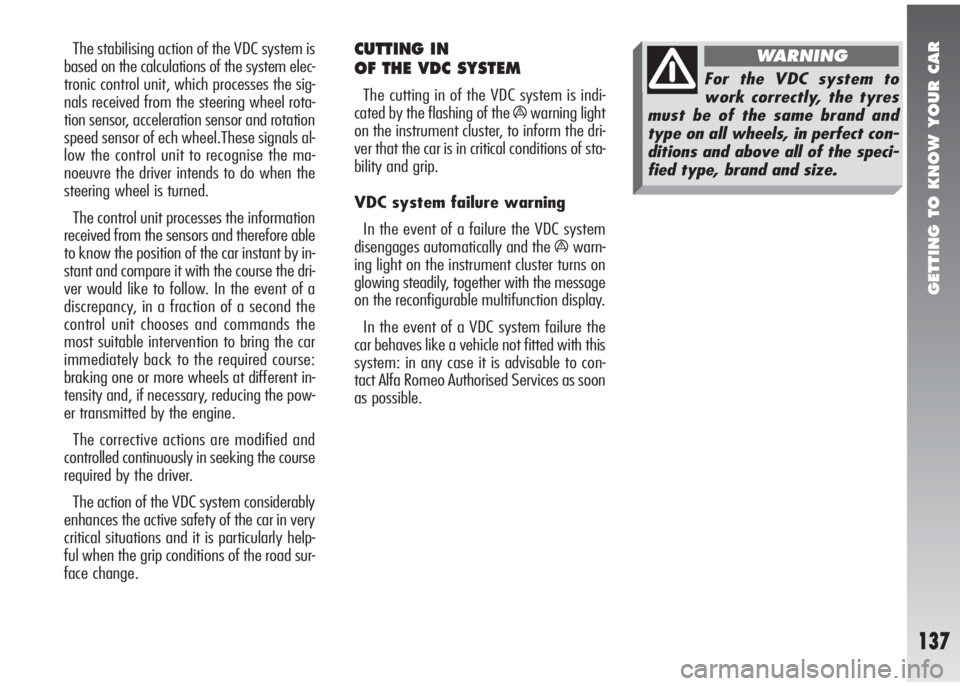
GETTING TO KNOW YOUR CAR
137
The stabilising action of the VDC system is
based on the calculations of the system elec-
tronic control unit, which processes the sig-
nals received from the steering wheel rota-
tion sensor, acceleration sensor and rotation
speed sensor of ech wheel.These signals al-
low the control unit to recognise the ma-
noeuvre the driver intends to do when the
steering wheel is turned.
The control unit processes the information
received from the sensors and therefore able
to know the position of the car instant by in-
stant and compare it with the course the dri-
ver would like to follow. In the event of a
discrepancy, in a fraction of a second the
control unit chooses and commands the
most suitable intervention to bring the car
immediately back to the required course:
braking one or more wheels at different in-
tensity and, if necessary, reducing the pow-
er transmitted by the engine.
The corrective actions are modified and
controlled continuously in seeking the course
required by the driver.
The action of the VDC system considerably
enhances the active safety of the car in very
critical situations and it is particularly help-
ful when the grip conditions of the road sur-
face change.CUTTING IN
OF THE VDC SYSTEM
The cutting in of the VDC system is indi-
cated by the flashing of the
áwarning light
on the instrument cluster, to inform the dri-
ver that the car is in critical conditions of sta-
bility and grip.
VDC system failure warning
In the event of a failure the VDC system
disengages automatically and the
áwarn-
ing light on the instrument cluster turns on
glowing steadily, together with the message
on the reconfigurable multifunction display.
In the event of a VDC system failure the
car behaves like a vehicle not fitted with this
system: in any case it is advisable to con-
tact Alfa Romeo Authorised Services as soon
as possible.
For the VDC system to
work correctly, the tyres
must be of the same brand and
type on all wheels, in perfect con-
ditions and above all of the speci-
fied type, brand and size.
WARNING
Page 176 of 291

GETTING TO KNOW YOUR CAR
174
EMISSION REDUCING DEVICES
Trivalent catalytic converter
(catalytic silencer)
The exhaust system is fitted with a cata-
lyst formed of alloys of precious metals; it
is housed in a stainless steel container which
is able to withstand the high operating tem-
peratures.
The catalyst converts the unburnt hydro-
carbons, carbon monoxide and nitric oxide
in the exhaust gas (even in minimal quan-
tity owing to the electronic ignition and in-
jection systems) into non polluting com-
pounds.Lambda sensors
Lambda sensors measure the content of
oxygen present in the exhaust gas. The sig-
nal transmitted by the Lambda sensors is
used by the injection and ignition electron-
ic control unit to adjust the air - fuel mixture.
Anti-evaporation system
As it is impossible, even when the engine
is switched off, to prevent the formation of
fuel vapours, a system has been devised
which traps the vapours in a special acti-
vated carbon container.
When the engine is running these vapours
are withdrawn and sent to combustion.
ENVIRONMENTAL
PROTECTION
The design and construction of the vehi-
cle have not only been developed with the
traditional aspects of performance and safe-
ty in mind, but also take into account the in-
creasingly pressing problems tied to pro-
tecting the environment.
The choice of materials, techniques and
particular parts are the result of work which
has made it possible to drastically reduce
the harmful effects on the environment and
guarantee compliance with the most strin-
gent international regulations.
USE OF NON-TOXIC
MATERIALS
None of the components of the vehicle con-
tain asbestos. The padding and the climate
control system do not contain CFCs which
are held responsible for the destruction of
the ozone layer.
The colouring agents and the corrosion in-
hibitors used on the nuts, screws and bolts
do not contain cadmium or chrome which
could pollute the atmosphere or water tables.
Due to the high tempera-
tures reached during oper-
ation of the catalytic silencer the
vehicle should not be parked over
inflammable materials (paper, fu-
el oils, grass, dry leaves etc.).
WARNING
Page 186 of 291
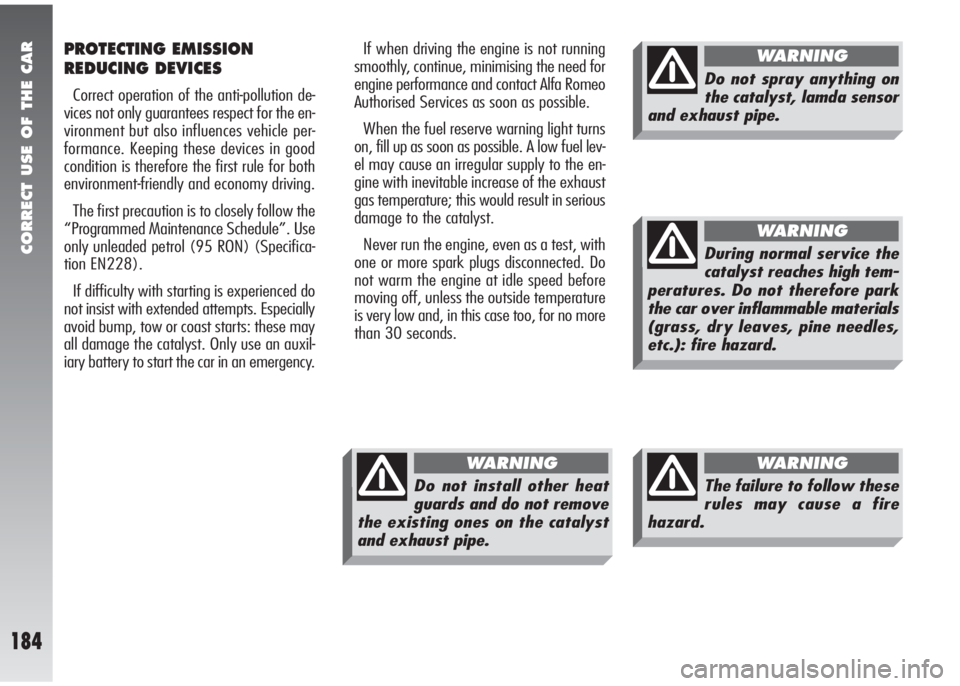
CORRECT USE OF THE CAR
184
PROTECTING EMISSION
REDUCING DEVICES
Correct operation of the anti-pollution de-
vices not only guarantees respect for the en-
vironment but also influences vehicle per-
formance. Keeping these devices in good
condition is therefore the first rule for both
environment-friendly and economy driving.
The first precaution is to closely follow the
“Programmed Maintenance Schedule”. Use
only unleaded petrol (95 RON) (Specifica-
tion EN228).
If difficulty with starting is experienced do
not insist with extended attempts. Especially
avoid bump, tow or coast starts: these may
all damage the catalyst. Only use an auxil-
iary battery to start the car in an emergency.If when driving the engine is not running
smoothly, continue, minimising the need for
engine performance and contact Alfa Romeo
Authorised Services as soon as possible.
When the fuel reserve warning light turns
on, fill up as soon as possible. A low fuel lev-
el may cause an irregular supply to the en-
gine with inevitable increase of the exhaust
gas temperature; this would result in serious
damage to the catalyst.
Never run the engine, even as a test, with
one or more spark plugs disconnected. Do
not warm the engine at idle speed before
moving off, unless the outside temperature
is very low and, in this case too, for no more
than 30 seconds.
Do not spray anything on
the catalyst, lamda sensor
and exhaust pipe.
WARNING
The failure to follow these
rules may cause a fire
hazard.
WARNING
Do not install other heat
guards and do not remove
the existing ones on the catalyst
and exhaust pipe.
WARNING
During normal service the
catalyst reaches high tem-
peratures. Do not therefore park
the car over inflammable materials
(grass, dry leaves, pine needles,
etc.): fire hazard.
WARNING
Page 216 of 291
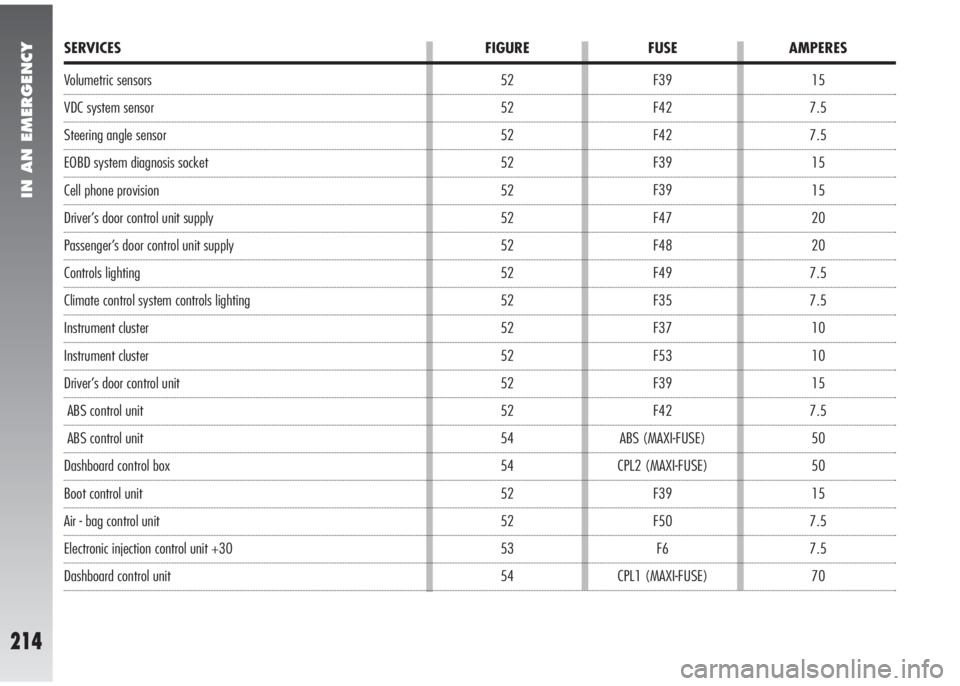
IN AN EMERGENCY
214
Volumetric sensors
VDC system sensor
Steering angle sensor
EOBD system diagnosis socket
Cell phone provision
Driver’s door control unit supply
Passenger’s door control unit supply
Controls lighting
Climate control system controls lighting
Instrument cluster
Instrument cluster
Driver’s door control unit
ABS control unit
ABS control unit
Dashboard control box
Boot control unit
Air - bag control unit
Electronic injection control unit +30
Dashboard control unit15
7.5
7.5
15
15
20
20
7.5
7.5
10
10
15
7.5
50
50
15
7.5
7.5
70 F39
F42
F42
F39
F39
F47
F48
F49
F35
F37
F53
F39
F42
ABS (MAXI-FUSE)
CPL2 (MAXI-FUSE)
F39
F50
F6
CPL1 (MAXI-FUSE) 52
52
52
52
52
52
52
52
52
52
52
52
52
54
54
52
52
53
54
SERVICES FIGURE FUSE AMPERES